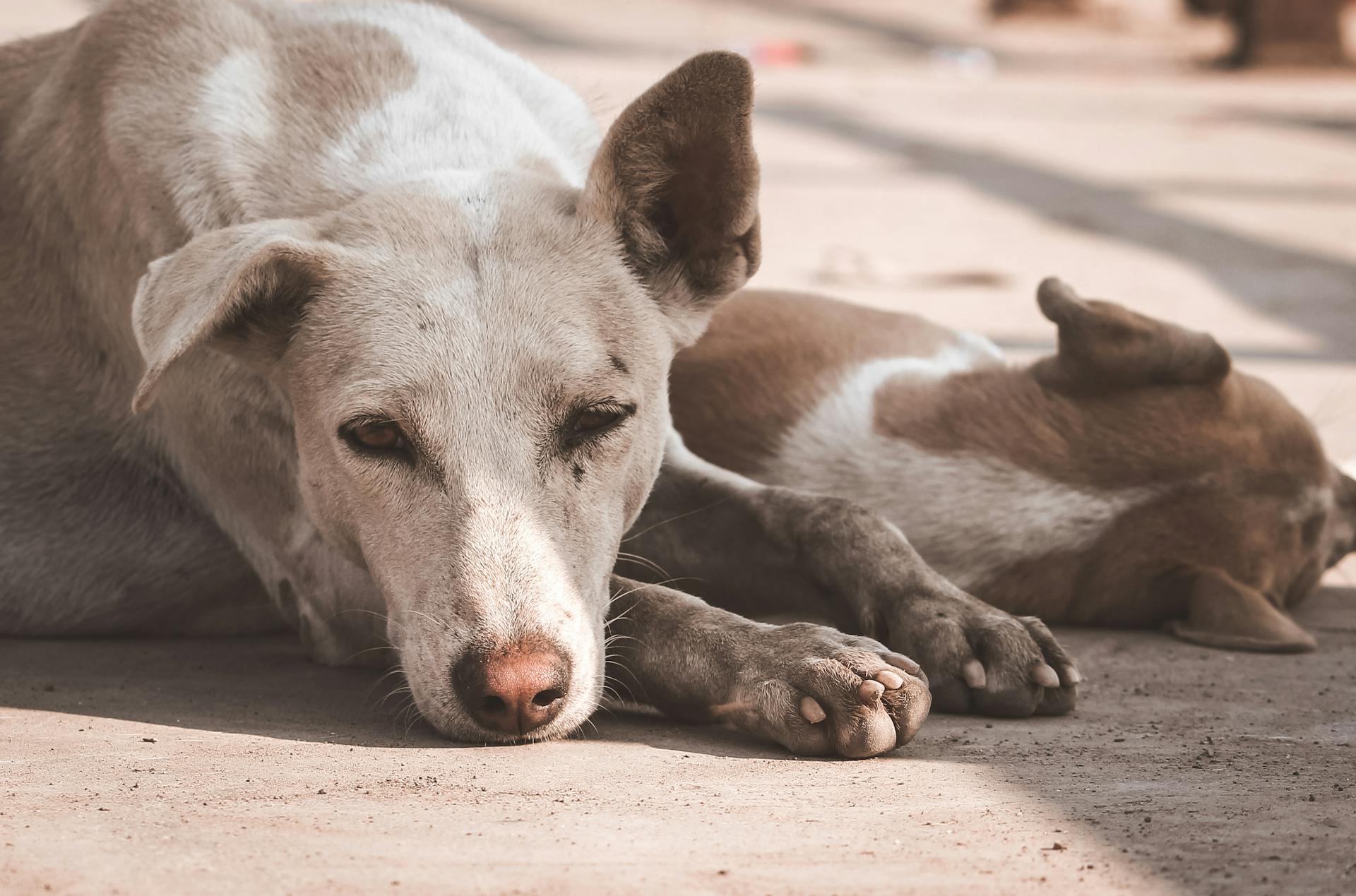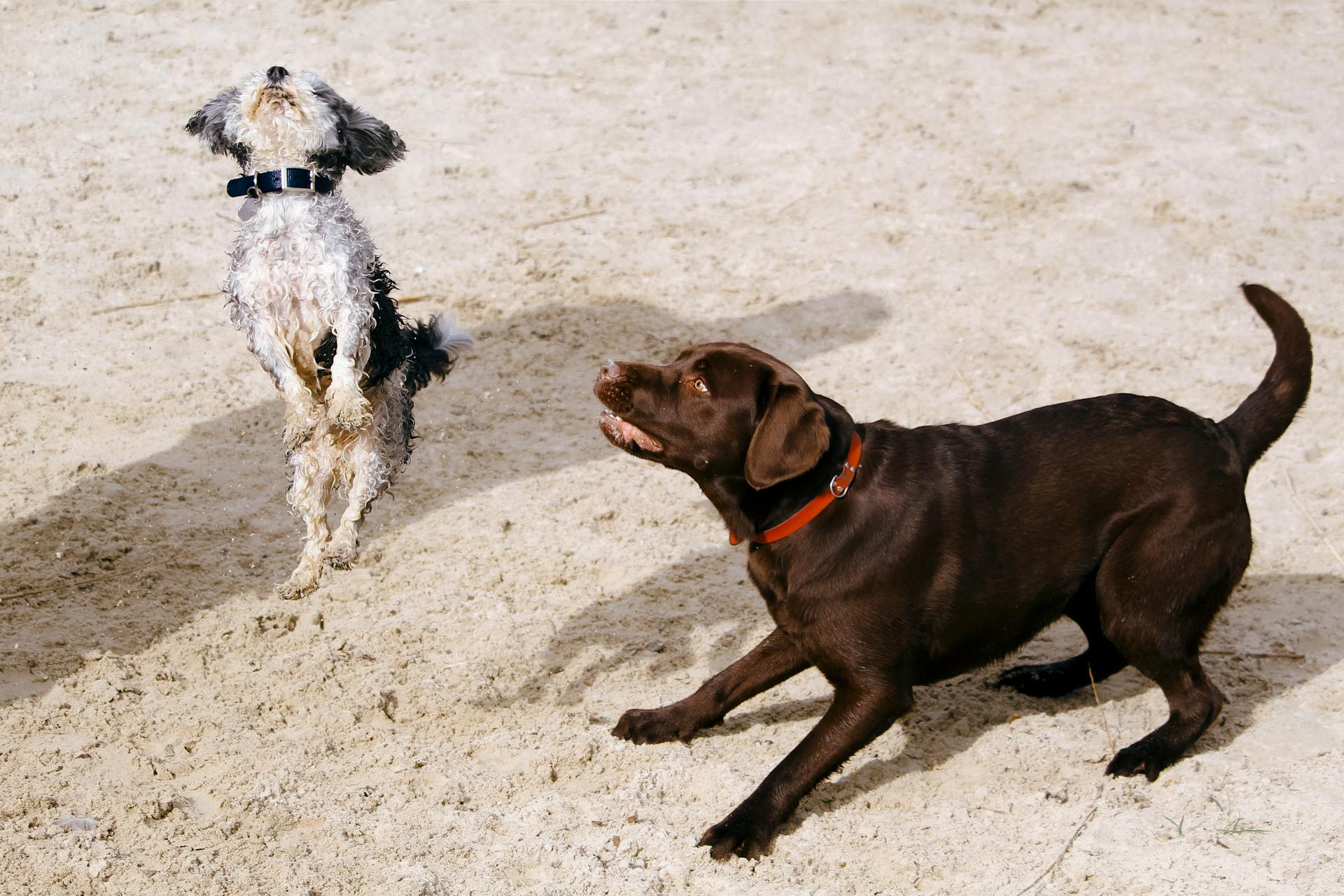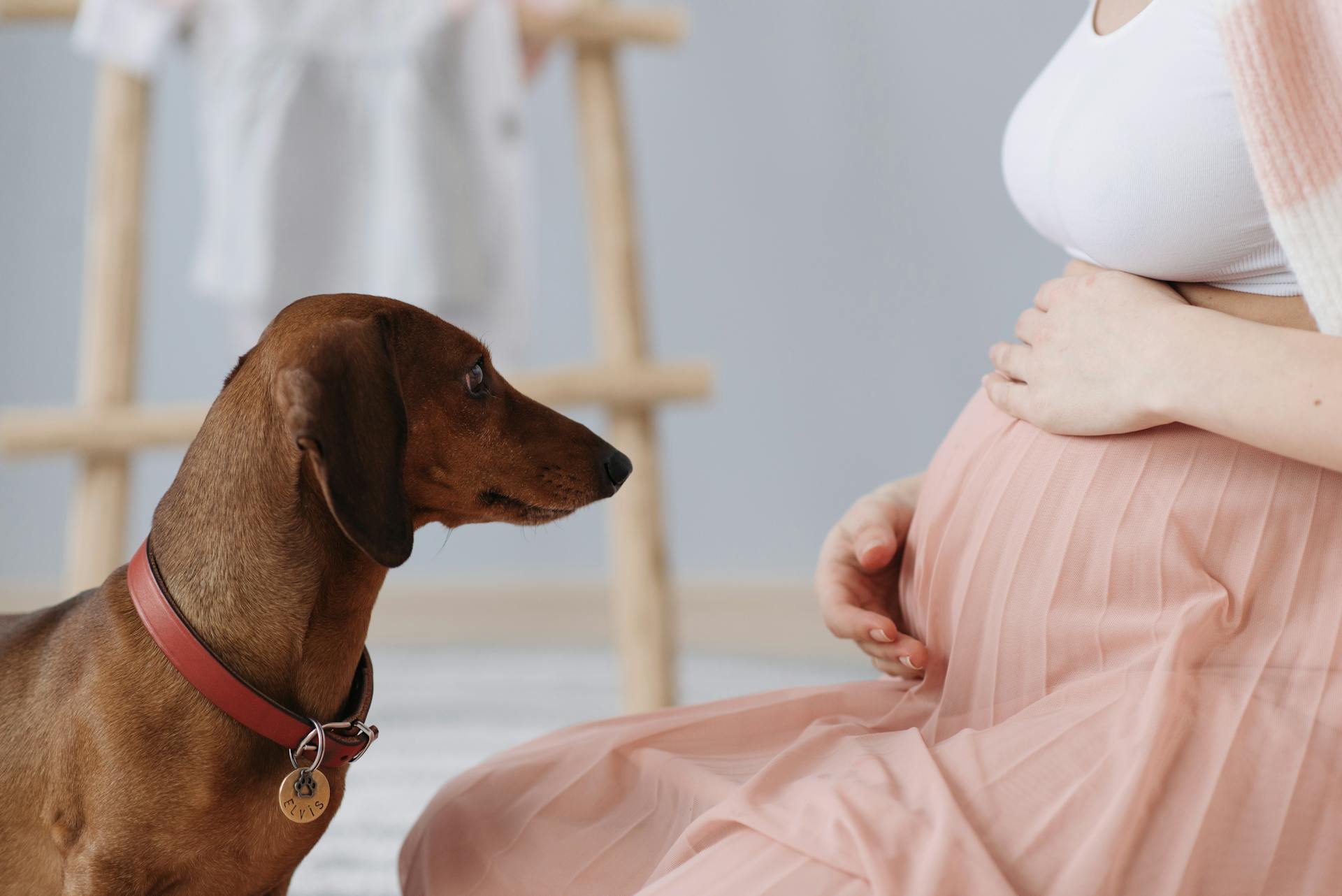
Dogs often expose their bellies as a sign of submission, which is a natural behavior for them. This can happen when they feel comfortable enough to let their guard down around their pack or human family.
Exposing their belly can also be a sign of trust. Dogs will often roll over and show their belly to their owners as a way of saying "I trust you" and "I feel safe around you." This is especially true for dogs that have been socialized well.
In the wild, a dog's belly is a vulnerable spot, so exposing it is a big deal. By showing their belly, a dog is essentially saying "I'm not a threat, I'm a friend." This can be a powerful way to diffuse tension and create a sense of calm.
Dogs may also expose their belly as a way to get attention or affection. If a dog is looking for belly rubs or playtime, they may roll over and show their belly as a way of saying "Hey, pet me!"
Why Dogs Show Their Belly
Dogs expose their belly as a sign of trust and submission, indicating they feel safe and comfortable around you. This vulnerable posture shows they’re not a threat and often seek positive interaction, comfort, or playtime with their human companions.
A dog's belly is one of its most vulnerable areas, and many dogs only reveal it to people or pets they deeply trust. This display is not just about asking for a belly rub—it’s a fascinating part of a dog’s body language.
There are several reasons why your dog might be showing its belly. Here are a few:
- Trust and Submission: Your dog exposing its belly can be a signal of trust. It’s like your dog is saying, “I trust you not to hurt me.”
- Seeking Attention: Wanting a pat or cuddle could be another reason. If you often respond to your dog’s belly display with affection, your pooch has likely learned this as a way to get more of that sweet attention.
- Cooling Down: Just like you might take off a layer when you’re hot, dogs can use their bellies to cool down.
- Relaxation: Sometimes, a dog showing its belly might be in the middle of a lazy stretch. It’s comfortable and relaxed – a canine version of lounging on the sofa.
- Playfulness: If your dog is in the mood to play, it might start by flopping onto its back. It’s an invitation for fun!
To better understand your dog's behavior, pay attention to the context in which they show their belly. For example, if they're looking relaxed, they might just be chilling out. If they're wiggly, they probably want to play. If they're showing their belly during a greeting, they're being submissive and saying "hi".
Understanding Canine Body Language
Dogs communicate with us through body language, and one of the most telling signs is when they show their belly. This can mean many things, including trust, fear, or playful intentions.
A dog that is afraid or being submissive will exhibit clear signs, such as exposing the belly, avoiding eye contact, or having a lowered body stance. The submissive belly expose is a plea for peace and often an attempt to avoid any escalation.
Here are some key signs to look out for:
- Tail tucking: A scared or submissive dog often holds its tail low or between the legs.
- Licking lips or yawning: These can be signs that a dog is stressed or uncomfortable.
In contrast, if your dog flops over to expose its belly, it's often a signal of contentment and ease, indicating they feel happy and safe in their environment.
Understanding Canine Body Signals
Dogs communicate with us through body language, and understanding these signals can strengthen your bond with your furry friend.
A dog that exposes its belly is often a sign of trust and submission, indicating they feel safe and comfortable around you.
Dogs may show their belly to initiate play or to signal a break during roughhousing with other dogs.
A relaxed dog that flops over to expose its belly is a sign of contentment and ease.
If a dog is licking its lips and avoiding eye contact while showing its belly, it's likely feeling anxious or stressed.
A happy dog will often wag its tail, keep its body loose, and stick its tongue out in contentment when receiving a belly rub.
Dogs have sensitive skin and nerve endings, so a light touch is best when giving a belly rub.
If a dog kicks its legs in delight or wags its tail during a belly rub, it's a sign that they're enjoying it.
A mother dog presents its belly to its puppies as a sign of trust and comfort, allowing them to nurse.
If a dog rolls over and presents its belly to you, it's often a request for a belly rub.
Here are some common canine body signals to look out for:
- Belly exposed while looking relaxed? Likely chilling out.
- Belly exposed with a wiggly body? Probably wants to play.
- Belly showing during a greeting? It's being submissive and saying "hi".
- Avoiding eye contact while showing belly? It might be feeling a bit anxious.
Cats Showing Their Belly
Cats expose their bellies for various reasons, including trust and comfort.
Dogs and cats are similar in that they both show their bellies as a sign of submission or trust, but it's not just about being cute.
Cats will often show their belly to their owners as a way to initiate play or affection.
By understanding these cues, you can build a stronger bond with your feline friend.
Cats that are feeling relaxed and comfortable may also expose their bellies as a way to show vulnerability and trust.
Take a look at this: Cats Show
Signs of Trust and Relaxation
Dogs show their belly as a sign of trust and relaxation, indicating they feel safe and secure in their environment.
A relaxed posture is a key indicator of trust, and dogs often display this when they're feeling calm and comfortable.
In fact, a belly-up position or a raised paw can show they're comfortable and seeking positive interaction.
If your dog exposes its belly to you, it's often a sign of trust and affection, and they might look at you with wide eyes, inviting you to engage, perhaps for a playful belly rub.
Dogs may also exhibit a relaxed mouth with a tongue lolling to the side, and a tail that's not tucked between their legs and is relaxed, when they're feeling comfortable and trusting.
A dog may be asking for a belly rub if they're exposing their belly combined with these signs:
- Relaxed, loose posture
- Open, relaxed mouth with tongue lolling to the side
- Eyes are not wide or alert
- Tail is not tucked between their legs and is relaxed
By paying attention to these signs, you can better understand your dog's behavior and build a stronger bond with them.
Comfort and Playfulness
Dogs expose their bellies to show they feel secure and happy. This behavior is a clear message that they trust you enough to show you their weakest spot.
Rolling on their backs is like plopping down on the couch after a long day – it's a safe spot to chill out. Dogs seek out comfort and security, and showing their bellies is a sign of feeling relaxed.
Sometimes, dogs roll on their bellies just to scratch a hard-to-reach itch. But often, they expose their bellies during play as an invitation for interaction from you or other dogs.
If your pup's mouth is open and their body is loose and wiggly, it's likely they're inviting you to play. A cute little play bow before flipping on their back is also a sign of a happy mood.
Sleeping belly-up is a good indicator that your pup feels perfectly at home. It's a sign of feeling secure and having no fear or anxiety at that moment.
Puppies show their bellies to each other during playtime, signaling a break during roughhousing or establishing a friendly intent. This playful submission can reduce potential aggression and foster bonds.
Rubbing and Affection
Dogs often expose their bellies as a sign of trust and submission, indicating they feel safe and comfortable around you.
A happy dog will wag their tail, keep their body loose, and often stick their tongue out in contentment when receiving belly rubs.
If your dog is making eye contact and his eyes, ears, and body appear relaxed, he's likely asking for pets. Try a few gentle pets at first and see how he reacts.
Dogs expose their belly to cool down, as the fur on their belly is thinner and the skin is less insulative, making it easier for them to chill out.
Here's a quick checklist to help you interpret your dog's body language:
A dog's belly is a vulnerable area, and many dogs only reveal it to people or pets they deeply trust. This display is not just about asking for a belly rub – it's a fascinating part of a dog's body language.
Broaden your view: Why Does a Dog Wag Its Tail
Behavioral Cues and Communication
Dogs use body language to communicate, and exposing their belly is one way they express themselves. Dogs can't speak, so they rely on non-verbal cues to convey their feelings and needs.
Rolling on their back and exposing their belly can mean different things, such as trust, submission, an invitation to play, or a call for attention. It's a way for dogs to communicate with their human family members and other animals.

A submissive dog may expose their belly as a plea for peace, often attempting to avoid any escalation. They might also exhibit other signs like tail tucking, licking lips, or yawning, indicating they're stressed or uncomfortable.
During playtime, puppies often show their bellies to each other as a sign of friendly intent and playful submission. This behavior helps establish bonds and reduce potential aggression.
As puppies grow, they learn canine social cues through interactions with adults and siblings. They pick up on the subtleties of body language, such as when to show their belly for play, peace, or submission. This learning is essential for their development into well-socialized dogs.
Here are some key behavioral cues to look out for:
- Tail tucking: A scared or submissive dog often holds its tail low or between the legs.
- Licking lips or yawning: These can be signs that a dog is stressed or uncomfortable.
Remember, understanding these cues can help you better respond to your dog's needs and emotions, deepening your bond and creating a more harmonious relationship.
Puppy Behavior and Development
Puppies show playful submission by exposing their bellies to each other, signaling a break during roughhousing or establishing a friendly intent.

This behavior is a deep-rooted part of dog speak, where exposing the belly can reduce potential aggression and foster bonds.
A wagging tail often accompanies this behavior, indicating excitement and happiness.
Puppies are still learning how to navigate social interactions, so it's not uncommon to see them exhibit this type of playful behavior.
Human Interaction and Preferences
Dogs often seek belly rubs by presenting their belly to their owners, showing they trust and enjoy the affectionate scratch or rub.
Rolling over and exposing their belly is a sign that dogs have found their owner to be a reliable source of comfort and relaxation.
This behavior is a pleasurable experience for dogs as it soothes an itch they can't scratch themselves.
Dogs know that their owners are the perfect people for the job, making them feel safe and content.
Sources
- https://k9basics.com/what-does-it-mean-when-a-dog-shows-their-belly/
- https://www.petsbest.com/blog/5-reasons-dogs-expose-their-belly
- https://funnyfuzzy.com/a/blog/why-do-dogs-like-belly-rubs
- https://pawsafe.com/blogs/dog-behavior/dog-showing-belly
- https://figopetinsurance.com/blog/why-do-dogs-love-belly-rubs
Featured Images: pexels.com


